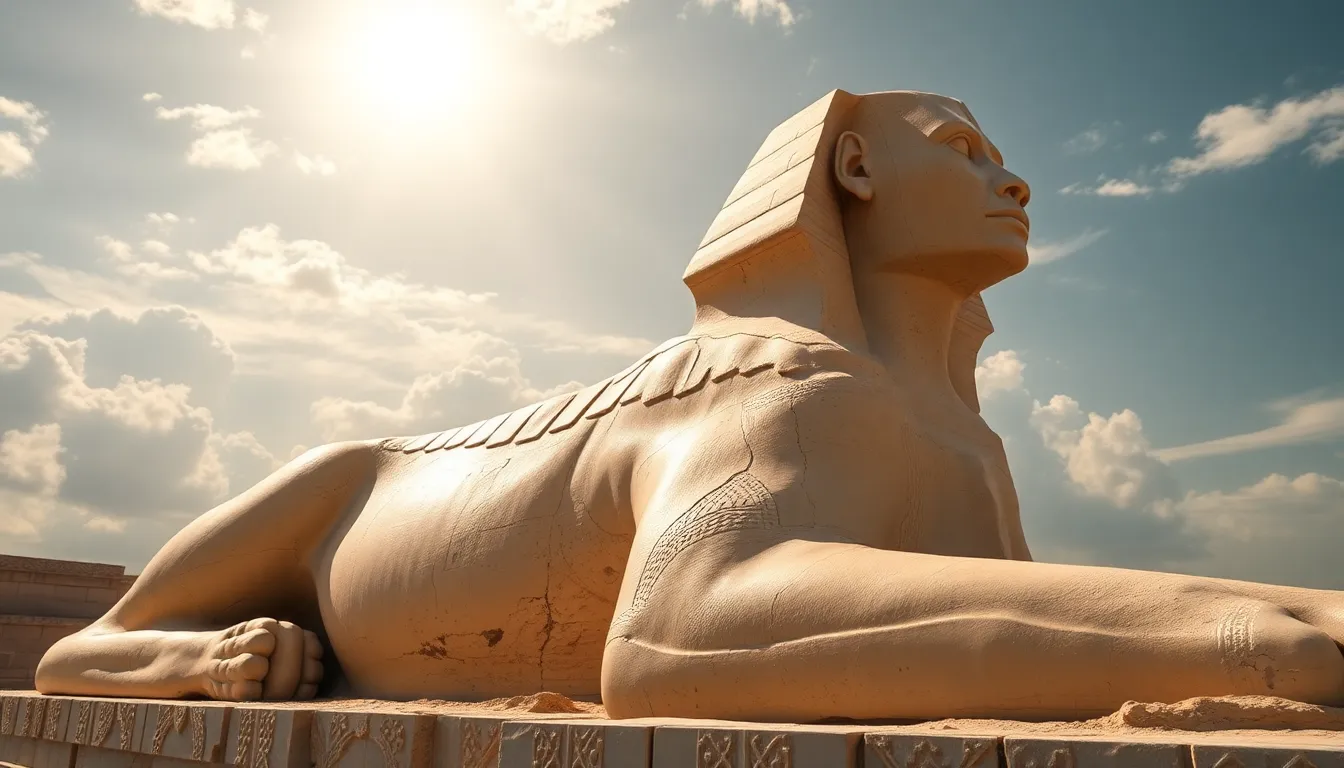The Sphinx and Its Connection to the Divine
I. Introduction
The Sphinx is one of the most iconic symbols of ancient Egypt, captivating the imaginations of people for centuries. With its majestic body of a lion and the head of a human, the Sphinx has been a subject of intrigue and reverence throughout history. Its historical significance is not merely in its monumental presence but also in its profound connections to the divine. This article explores the intricate relationships between the Sphinx and the Egyptian pantheon, its role within society, and its enduring legacy.
II. The Sphinx: A Symbol of Power and Protection
A. Description and characteristics of the Sphinx
The Great Sphinx of Giza, standing at approximately 66 feet tall and 240 feet long, is a testament to the architectural prowess of ancient Egyptians. Its features are striking, with a serene face that is believed to represent Pharaoh Khafre, showcasing the idealizations of royal power. The Sphinx’s body, a powerful lion, symbolizes strength, courage, and protection.
B. The Sphinx’s role in ancient Egyptian society
In ancient Egyptian society, the Sphinx was seen as a guardian figure. Positioned at the Giza plateau, it served as a sentinel to the nearby pyramids, which were monumental tombs for the pharaohs. The Sphinx was not only a symbol of royal authority but also a protector of the sacred spaces surrounding it.
III. Mythological Origins of the Sphinx
A. The Sphinx in Egyptian mythology
The Sphinx has its roots deeply embedded in Egyptian mythology. It is often associated with the concept of wisdom and mystery. Egyptian mythology tells of the Sphinx as a creature that posed riddles to those who dared to approach it, echoing the idea of knowledge being a gateway to the divine.
B. Connections to gods and goddesses, particularly Horus and Ra
The Sphinx is closely linked to the sun god Ra, who was believed to rise in the east. This celestial connection highlights the Sphinx’s role as a guardian of sacred knowledge and truth. Additionally, the Sphinx is connected to Horus, the falcon-headed god, representing kingship and protection. The Sphinx embodies qualities of both gods, reinforcing its divine associations.
IV. The Architectural Significance of the Sphinx
A. Construction and alignment with celestial bodies
The construction of the Sphinx is a marvel of engineering and astronomical precision. It is aligned with the stars, particularly the constellation of Leo, which signifies the lion’s strength. This alignment not only serves a practical purpose but also imbues the Sphinx with cosmic significance, connecting it to the divine order of the universe.
B. Symbolism in its design and positioning
The design of the Sphinx reflects a harmonious blend of human and animal features, symbolizing the union of intellect and strength. Its positioning at the entrance of the Giza plateau serves as a threshold to the afterlife, where the Sphinx watches over the souls of the departed, ensuring safe passage into eternity.
V. The Sphinx in Religious Practices
A. The Sphinx’s role in rituals and ceremonies
The Sphinx played a significant role in various religious practices. It was often involved in rituals that honored the pharaohs and sought the favor of the gods. Festivals would be held in its vicinity, celebrating the divine attributes it represented.
B. Its significance in funerary beliefs and the afterlife
The Sphinx was intimately connected to funerary beliefs in ancient Egypt. It was believed to guard the tombs of the pharaohs, ensuring that they were protected from any malevolent forces. The Sphinx’s presence was thought to facilitate the journey of the deceased into the afterlife, where they would be judged by Osiris and reunited with the gods.
VI. Interpretations and Theories of the Sphinx’s Meaning
A. Scholarly interpretations of the Sphinx’s symbolism
Scholars have long debated the meaning and symbolism of the Sphinx. Many interpretations suggest that it represents the idea of protection and wisdom, embodying the qualities of the ruling pharaoh and the divine. The Sphinx is often seen as a bridge between the mortal and the divine realms.
B. Alternative theories regarding its divine connections
- Some theorists propose that the Sphinx was originally a representation of a specific goddess, potentially Sekhmet, the lioness goddess of war.
- Others suggest that it served as a marker for astronomical events, further emphasizing its connection to celestial phenomena.
VII. The Sphinx in Art and Literature
A. Representation of the Sphinx in ancient and modern art
The Sphinx has been a source of inspiration in both ancient and modern art. From statues and reliefs to paintings and sculptures, the image of the Sphinx has been utilized to convey themes of mystery, power, and the divine. Its form has been reinterpreted in various cultures, signifying a universal allure.
B. Literary references and their implications on divine connections
In literature, the Sphinx appears as a symbol of enigma and challenge. The most famous literary reference comes from Greek mythology, where the Sphinx poses riddles to Oedipus. This portrayal highlights the Sphinx’s role as a guardian of knowledge and truth, reinforcing its connections to divine wisdom.
VIII. Conclusion
In summary, the Sphinx is a multifaceted symbol with deep connections to the divine in ancient Egyptian culture. Its representation of power, protection, and knowledge underscores its significance in both the physical and spiritual realms. As a guardian of the afterlife and a sentinel of sacred spaces, the Sphinx continues to captivate our imagination and invites us to explore the mysteries of the divine.
The enduring legacy of the Sphinx in culture and spirituality serves as a reminder of humanity’s quest for understanding and connection with the divine. Its majestic presence stands as a testament to the ancient Egyptians’ reverence for the gods and their intricate belief systems.




